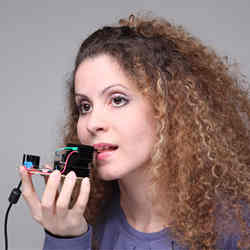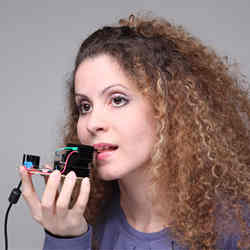
Over the last quarter-century, advances in digital technology have transformed the way we approach a vast array of activities. We shop online, order movies through the Internet, snap digital photos, and listen to digitized music. While it envelops a significant and growing chunk of our lives, the digital world continues to revolve primarily around two senses: seeing and hearing.
That may soon change.
"There is an ongoing desire to merge the physical world and the virtual world through what is known as augmented or mixed reality," says Adrian David Cheok, a professor of pervasive computing at City London University in the U.K. "There is a growing interest in building systems that incorporate all of our senses." Such emerging technologies have application in fields like retail, medicine, environmental biology, chemistry, and food and beverage.
However, designing, building, and deploying technology that can simulate the tactile experience of touching a fabric or animal, the smell of a candle or perfume, or the taste of a dish from a restaurant remains elusive. "Light and sound can be captured as wavelengths and digitally reproduced in a very precise way," Cheok explains, adding that taste, touch, and smell profiles are incredibly complex. Adds Philip Kortum, an assistant professor in the Department of Psychology at Rice University and a leading human factors expert, "There are enormous challenges associated with reproducing other senses."
Sensing: the Next Generation
The introduction of technology that gibes with human senses and thinking could prove transformative. "More than half of human communication is non-verbal, and taste and smell are connected to the limbic system of the brain, which is responsible for emotion and memory," Cheok says. "Today’s digital technology represents only part of the human sensory experience."
Over the last decade, Cheok and fellow researchers have developed several devices that address digital touch, smell, and taste in a basic way. So-called "huggy pajamas" allow a person to wear a suit and feel a hug virtually. Haptic rings let a person squeeze a ring and another person wearing a corresponding ring can feel the sensation virtually. A small electronic box uses electrodes to excite taste receptors on the tongue, producing basic taste sensations.
Others have developed devices that address other sensory tasks. For example, a team at the National University of Singapore is experimenting with a digital lollipop that tricks the tongue into sensing sweet, salt, sour or bitter tastes.
Several private firms are also working to develop sensory technology. For instance, San Francisco-based Adamant Technologies is developing a small processor that digitizes smell and taste, and interprets odors. The company hopes manufacturers will embed the sensor in future smartphones. The system uses about 2,000 sensors to detect aromas and flavors, compared to about 400 "sensors" that reside in the human nose.
Research revolving around smell is developing rapidly. Food manufacturers already use sensors to ensure the taste and smell of food is duplicated precisely across global plants. At a consumer level, a Japanese company called Scentee has introduced a device that emits basic fragrances from an Android smartphone or iPhone using reservoirs of alcohol-based solutions. The unit produces the smell of coffee, cinnamon rolls, coconut, mint, roses, strawberries, and other things. However, the machine doesn’t produce the full spectrum of scents the human nose can detect; for example, it creates the smell of coffee using 15 different molecules rather than the 150 molecules required in real coffee, Cheok points out.
Beyond Computing
The goal, Kortum says, is to build more natural interfaces that incorporate human senses and traits. Although the science associated with smell, taste, and touch is marching forward, obstacles remain. There is the task of replicating molecule profiles accurately, and the technical and cost challenges associated with designing and manufacturing chemical cartridges that can produce hundreds of thousands, or more, scents. More advanced technology that stimulates the tongue, fingers, and brain in a specific way is still in the nascent stages.
Another obstacle, Cheok points out, is that people experience chemical scents and electrical signals in somewhat different ways (though the latter approach is far more precise). "If we put an image on a screen and ask people what they see, we will get a nearly 100% accuracy rate. However, if we ask people to smell or taste something, we might get an 80% success rate," he explains.
Nevertheless, rapid advances in processing power, better sensors, and a deepening understanding of the brain and psychology will lead to immersive virtual sensory applications in the coming years, Kortum says. We will likely feel and smell materials virtually and custom-order clothing, fragrances, and other goods online; sample recipes through virtual taste systems, and visit virtual zoos where it will be possible to stroke the mane of a lion or touch the skin of a whale.
Says Cheok: "Eventually, we will do most of the things we do in the physical world within the virtual world. The only limit is human creativity."
Samuel Greengard is an author and journalist based in West Linn, OR.




Join the Discussion (0)
Become a Member or Sign In to Post a Comment